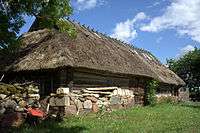Muhu
Muhu is the third largest island in Estonia, although it is fairly small at 198 square kilometres. It's located between the mainland and Saaremaa Island.
Understand
Over the centuries Muhu has developed at its own pace and its traditions are well known throughout Estonia. The famous Muhu patterns are a refined expression of folk art.
The inhabitants of Muhu call themselves Muhu people; a self chosen title which radiates a certain pride and feeling of being different from mainlanders or communities on other islands.
Get in
By ferry
Muhu Island is connected by a frequent ferry service from Virtsu on the mainland to Kuivastu on Muhu. The ferries take cars and make the crossing in 25 minutes. Reservations are highly recommended specially during weekends. The ferries are operated by Saaremaa Laevakompanii.
By ice road
During winter time, an ice road connects the mainland to Muhu. An ice road differs by letting people drive at quite a high speed with safety belts open. The speed is reduced only while approaching the cracks that one has to cross over the boards fixed on the cracks. It takes approximately 20 minutes to cover the distance in case of favourable conditions. You can even pass the ferries that "drive" on the next line.
By bus
Muhu is well connected by a network of buses from most other cities in the region and from Tallinn. Bus schedules can be found at Bussireisid.
Get around
See

The nature of Muhu has been left largely undisturbed in the past fifty years. It's the natural habitat to 23 species of very rare orchids. Muhu is also home to many migrating birds, which take temporarily shelter in the various bays.
Villages on Muhu are even today still headed by traditional village eldermen, who take up the role of voluntary counsel. Many of the villages are charming in their simplicity and worth having a look (especially because in terms of tourism, Muhu has remained rather untainted so far).
- St Catherine Church. It's one of the oldest in Estonia and is notable for its trapezium-shaped tombstones with pagan symbols. The most intricate tombstone depicts the pagan Tree of Life.
- Üügu Bluff. It's the largest and most attractive of Muhu's many bluffs being ca. 300m long.
- Muhu Museum, Koguva village, Muhu vald. The museum is located in the beautiful Koguva village. It's also the birthplace of Estonian writer Juhan Smuul.
Do
Each midsummer, a jazz music festival takes place in Muhu, featuring famous international musicians and attracts jazz fans from far and wide.
Eat
- Pädaste Manor, Pädaste village. See info in Sleep section below.
Sleep
The official Estonian tourism website provides an extensive list of options for accommodation in Muhu .
- Pädaste Manor, Pädaste village. The earlier history of the manor begins in the 16th century. In the end of 17th century an orchard was created in addition to the mansion and other manor buildings. By the 19th century the number of peasants had grown to two hundred. The facade of the mansion and the lawn is framed by two rows of imposing rubble stone buildings. The manor had its own windmill, lime furnace and brickfield. Today the mansion is occupied by luxurious SPA hotel.
Go next
- Saaremaa – The largest Estonian and wild seaside character island with castles and fortresses, one perfectly preserved, a beach, a spa and famous mills. Saaremaa is even sometimes called Sparemaa. Furthermore, the island itself is surrounded by a myriad of tiny islands including Abruka with its nudist camps.
- Hiiumaa– The second largest Estonian island. Popular for its lighthouses, ancient churches, historical values and the sense of humour of its inhabitants, but scarcely populated. In winter, it can sometimes be reached by car via an ice bridge on the Baltic Sea.
- Vormsi – The fourth largest Estonian island, very close to the mainland. Vormsi is a small island covered with forests and a Swedish community. A unique blend of Soviet and Swedish history mixed with unspoilt nature.
- Pärnu – Estonia's 4th largest city and the summer capital of Estonia, popular for its balneo-therapy complexes and spa centres, surrounded by numerous beaches.